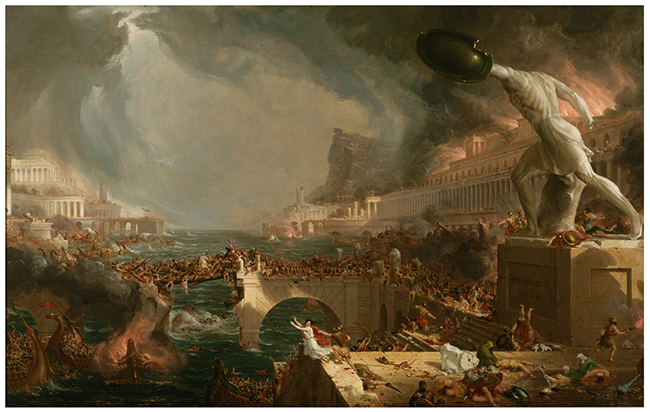Is it mere coincidence that every 100 years, the world is devastated by a pandemic?
From the Great Plague of Marseille in 1720 … to the Cholera pandemic of 1820 … to the Spanish Flu circa 1920 …
Pandemics seem to appear like clockwork. And major ones on even longer timeframes.
Last summer, I showed how civilizations “peak” on average every 1030 (and 512) years.
Elites then turn on each other to monopolize the spoils, which leads to economic, social and political mayhem …
… and, more often than not, a roaring pandemic.
These collapses also tend to be exacerbated by incompetent leadership, food shortages and forced migrations … which add even more fuel to the pandemic fire.
I hate to say this, but COVID-19 could be just the beginning of sorrows.
Even Dr. Mike Ryan, head of the WHO Emergencies Program, said the current pandemic is “not necessarily the big one” and that “the next pandemic may be more severe.”
So, why do major pandemics break out at these times?
One word: GLOBALISM.
From the Romans to the Mongols to the present day, major civilizations trade aggressively and invade new ecosystems … spreading germs.
The Antonine Plague offers an instructive tale.
This pandemic — most likely smallpox — flared up at the peak of the Roman empire, during the reign of Marcus Aurelius in 165 AD, and continuing under his son Commodus.
At one point, up to 3,000 Romans dropped dead daily. By the end of the outbreak in 180 AD, close to a third of the empire — upwards of five million people — had perished.
(The emperor actually blamed Christians for the pandemic, as they failed to praise the gods … enraging them enough to unleash the plague. But Christianity actually rose in popularity, as Christians were among the few willing to take in the sick … or those left destitute by the plague.)
Emperor Marcus Aurelius himself may have succumbed to the disease. (No, he wasn’t murdered by Commodus as in the 2000 film “Gladiator”).
Ironically, it was the empire’s expansive reach and efficient trade routes that facilitated the virus’s spread. Well-connected and overcrowded cities quickly became epicenters for transmission (sound familiar?).
So, with the economy in shambles, people from the upper classes — which had grown so large, their competition for power incited the kind of political polarization now eroding the foundations of the U.S. — fell into the lower ones … something unimaginable to those accustomed to Roman exceptionalism.
In the end, it was the demise of the greatest empire the world had ever seen.
The Spanish flu of 1918 is another example.
It erupted during a period of unprecedented global movement of people. In Europe, troops from all over mingled with Chinese workers building trenches for the warring empires. The crowded Western front helped the flu virus become even more virulent.
Steamships then brought the pandemic everywhere in record time, killing more than 100 million in a world occupied by only 1.8 billion people (it’s now 7.8 billion).
Now consider the COVID-19 pandemic.
The second half of the 20th century saw exponential population growth and unprecedented globalization. The novel coronavirus eventually emerged in China, the world’s fastest-rising economy …
… and a global crossroads, as it sends products and emissaries to the four corners of the planet to advance its economic interests.
At the time of the SARS outbreak in 2003, China had about 233 international airline routes. Just 16 years later, it offered COVID-19-infected passengers almost 800 routes. Over that same period, the number of Chinese travelers jumped from three million to 53 million per year.
Plus, Wuhan, where the pandemic started, is a major transportation hub for central China. Every year it facilitates the largest human migration on the planet as hundreds of millions of Chinese celebrate the Lunar New Year.
More Pandemic Cycles
If you’ve been with me for a while, you may have heard mention of a man by the name of Edward R. Dewey, who was commissioned by President Herbert Hoover to study the reasons behind the Great Depression.
In the years following, he discovered and described cycles in economics, biology, sociology and physics.
One of the clearest cycles Dewey uncovered was an 18.5-year cycle of “booms and busts” … now believed to be the 18.6-year real estate cycle of W.D. Gann.
Although Dewey didn’t recognize a pandemic cycle, others have …
Like Michel Jacquemai, a Swiss financial analyst and hedge fund manager who researches repeating cycles in weather … and global events like pandemics.
After evaluating data from the past 1,500 years, Jacquemai found that pandemics (or epidemics) reoccur about once every 9.3 years …
… exactly HALF of the 18.6-year cycle.
The COVID-19 pandemic — a mild affair in the scheme of things — tells us we’re facing the beginning of a historic convergence of cycles, where hyper-connectivity could rapidly lead to a decline — if not a collapse — of the current order.
On the positive side, the world is now fighting back with a flurry of unprecedented technology against these civilization-killing events.
One company on my radar is ready to hand you handsome profits in the fight against these invisible enemies (like the one that’s already done such damage to America and her economy) …
… in addition to a host of treatments for other ailments.
In 2019, the firm generated sales of $23.4 billion. But it hasn’t been resting on its laurels. It recently acquired the rights to a famous psoriasis drug. That product generated around $1.6 billion in sales in 2018.
It’s been highly rated by the Weiss Ratings system for the past half-decade, paying a generous quarterly dividend of $1.76 per share.
Get the full story from my special report — “American Heroes” — as a valued subscriber of Wealth Megatrends.
All the best,
Sean





